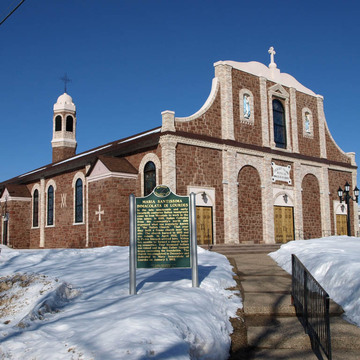You are here
Immaculate Conception Church (Italian Catholic Church of Mary Immaculate of Lourdes/Chiesa Cattolica Italiana Maria Santissima Immacolata Di Lourdes)
Complete with an attached campanile in the rear, this vernacular version of an Italian Renaissance church was built in an Italian enclave in the Gay Subdivision of Iron Mountain, on land purchased from the Houghton Mineral Land and Mining Company. Sandstone quarried locally on Millie Hill was used, and the labor was furnished by volunteers overseen by the Reverend Giovanni Pietro Sinopoli. Reverend Sinopoli was a native of Catonia, Sicily, and a member of a religious order founded by Bishop Scalebrini to care for Italian immigrants. He arrived in Iron Mountain in April 1902; the church was dedicated nine months later. A false front with connecting volutes over the side aisles makes up the primary facade of the church. The interior is arranged with a nave and side aisles. Decorative octagonal ribs are applied to the barrel-vaulted ceiling. The Menominee Stained Glass Works manufactured the stained glass windows. Anton Rezek, an early-twentieth-century historian of the Diocese of Marquette and Sault Ste. Marie, described the red sandstone church in 1907 as being “in style exclusively Italian so that one cannot mistake the character of the building nor the nationality of its owners.”
Writing Credits
If SAH Archipedia has been useful to you, please consider supporting it.
SAH Archipedia tells the story of the United States through its buildings, landscapes, and cities. This freely available resource empowers the public with authoritative knowledge that deepens their understanding and appreciation of the built environment. But the Society of Architectural Historians, which created SAH Archipedia with University of Virginia Press, needs your support to maintain the high-caliber research, writing, photography, cartography, editing, design, and programming that make SAH Archipedia a trusted online resource available to all who value the history of place, heritage tourism, and learning.


